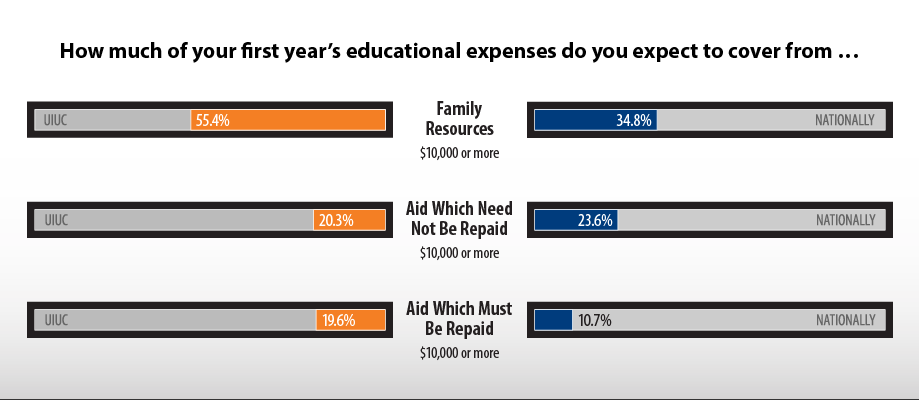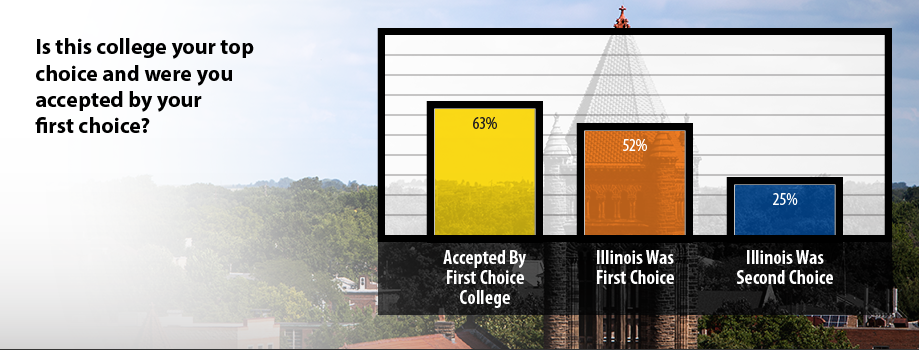2013 CIRP Freshman Survey
Main Content
Published November 2014
Like their counterparts nationally, University of Illinois students were influenced by the economy and have concerns about the affordability of a university education. Over half of UI freshmen (55.4%) expect their families to spend $10,000 or more compared to their counterparts nationally (34.8%). UI students are also relying more heavily on large loans (19.6%) than other students nationally (10.7%) to pay for college expenses. Almost 70% of UI freshmen reported that the economy influenced their college choice compared to 68% of their peers nationally.
The current economic situation significantly affected my college choice.
University of Illinois at Urbana-Champaign
- 24.8% – Agree strongly
- 44.3% – Agree somewhat
Public Universities Nationally
- 26.6% – Agree strongly
- 41.5% – Agree somewhat

Do you have any concern about your ability to finance your college education?
UIUC
- 18% – Major (not sure I will have enough funds to complete college)
- 55.3% – Some (but I probably will have enough funds)
Nationally
- 12.4% – Major (not sure I will have enough funds to complete college)
- 54.7% – Some (but I probably will have enough funds)

How much of your first year's educational expenses do you expect to cover from family resources?
$10,000 or more
- 55.4% – UIUC
- 34.8% – Nationally
How much of your first year's educational expenses do you expect to cover from aid which need not be repaid?
$10,000 or more
- 20.3% – UIUC
- 23.6% – Nationally
How much of your first year's educational expenses do you expect to cover from aid which must be repaid?
$10,000 or more
- 19.6% – UIUC
- 10.7% – Nationally

What are the chances you'll get a job to help pay for college expenses?
UIUC
- 49.9% – Very good chance
- 33.4% – Some chance
Nationally
- 50.1% – Very good chance
- 32.8% – Some chance

What are the chances you'll work full-time while attending college?
UIUC
- 5% – Very good chance
- 20.8% – Some chance
Nationally
- 7.3% – Very good chance
- 23.4% – Some chance

More UI freshmen plan on obtaining a degree beyond their bachelor's. 45.3% of UI freshmen plan on obtaining a master's degree and 23.9% plan on a doctorate degree. In comparison, nationally 40.8% of freshmen plan on obtaining a master's degree and 20% a doctorate.
Is this college your top choice and were you accepted by your first choice?
- 63% – Accepted by first choice college
- 52% – UIUC was first choice
- 25% – UIUC was second choice

For over 75% of UI freshmen, the University of Illinois was either their first or second college choice.
Number of college applications submitted by freshmen at UIUC and nationally.
UIUC
- 5.1% – Only 1 application submitted
- 56.8% – 1-5 applications submitted
- 20.2% – 7-10 applications submitted
Nationally
- 11.6% – Only 1 application submitted
- 58.1% – 1-5 applications submitted
- 17.5% – 7-10 applications submitted

A small percentage (5.1%) of UI freshmen only applied to Illinois in comparison to nationally (11.6%). Over half (56.8%) of UI freshmen applied to 1-5 colleges; which is closer to the national average of 58.1%. A little over 20% of UI freshmen applied to 7-10 schools; which is higher than the national average of 17.5%.